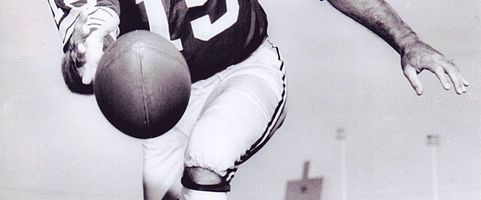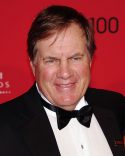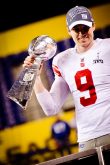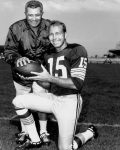Reports of his declining health had been disseminating in the media for the past two years. On May 26th, it was announced that football great and one of the last remaining sport standards in America, Bart Starr, had died.
And the Birmingham native (b.1.9.34) died. He did not ‘pass away,’ I think the dead, as the living, deserve the truth, without the sugar-coat.
——–
Bart Starr: The name has stood as a monument, not only to his athletic achievemnents and community spirit, a reputation known throughout the Great Lakes region, but just because it rolls off the tongue in an easy, convincing cadence, kinda’ like Mickey Mantle, Willie Mays, Jim Thorpe, Roberto Clemente, Charlie Chaplin, Jean Gabin, Kodachrome and Betsy Ross, the latest victim (along with some poor Nike designer who never saw boycott coming) of self-promoter, ex-NFL quarterback, Colin Kaepernick.
Known for his low-key demeanor off-field and trademark on-field spiral, both forward (Dowler) and back (Taylor – Hornung), Bart’s career passing numbers, pretty nifty during his run-oriented pro playing days (1956-71), would pale in comparison to those of today’s prolific, pass-happy signal-callers.
But unbeknownst to the online junior journalist who think the NFL began wih sabrmetrics and fantasy gamble, the gold-standard in sport is measured in championship metallica, not personal statistics, its karat count weighted in quality of competition. That silver standard in stats is not without real value, and has precipitated numerous Cantonese in bronze bust (Moon Marino Tarkenton Fouts Kelly), but it ain’t gold.
A 17th round draft selection out of Alabama by the Packers in 1956, Starr is revered by the masses, largely for his captaincy of the Green Bay franchise in a rebirth of greatness to six NFL title games, including runs of two (1961-62) and three (65-67) consecutive championships, the later culminating in the first two Super Bowl wins (v. KC-OAK) where Bart was voted game MVP in both contests, the 1966 AP NFL MVP and an automatic Canton inductee (77).
In the wake of his death, two interlocking questions arise, correction, SHOULD arise amongst those who write about the game‘s greats: 1) Was Bart Starr the #1 quarterback in NFL history, and, 2) Were his Green Bay Packers the greatest team the League has ever known? First, to the team query.
Any authorship of a article on the NFL’s top teams has to begin with the Curly Lambeau Packers and George Halas’ Monsters of Midway, the Chicago Bears.
And there is a problem. Their era (1920s-40s) is a distinct one, so void of the pass-game (QB = single-wing tailback) that took hold in the post-War period, Redskins’ Slingin’ Sammy Baugh excepted, that they must be excluded from the greatest team debate, as game-shaping as both men would prove. Where they DO rate are amongst the game’s greatest gurus: Lambeau, Halas, Neale, Brown, Parker, Lombardi, Gillman, Stram, Saban, Ewbank, Noll, Landry, Madden, Gibbs, Walsh, Seifert, Flores, Parcells, Johnson, Carroll and Belichick.
This period saw the pro game begin an evolutionary process where passing would prove the prime mover. Interestingly, such change conformed with the military itself where air-attack settled the issue in both WW2 theaters, Germany and Japan. Though ‘three-yards-and-a-cloud-of-dust’ was still the 40s standard play, scoring was fast becoming the peoples choice. Roost rulers in the period: City of Chicago (Bears 46 / Cards 47) and Brotherly Love (Eagles) (48-49).
The last non-Super decade, 1950s displayed three multi-championship clubs: Detroit Lions (52-3, 57) (Layne & Schmidt), Cleveland Browns (50, 54-5) (AAFC 1946-9; NFL 1950 >) (innovator Paul Brown and QB Otto Graham) and Weeb Ewbank’s Baltimore Colts (58-9) where the Johnny Unitas legend was born.
Next up, Bart’s decade, the 1960s.
It is the decade when the NFL began to supplant baseball as America’s top sport entertainment. Firstly, in merge with rival American Football League (71), second, with Cmsr Pete Rozelle’s nifty negotiation of lucrative TV network deals, and then with the arrival of Mr. Vince Lombardi, formerly of Fordham (player) and NY Giants (DC), in Green Bay (59) to turn a once proud Packers franchise into what many still consider the greatest ball-club in the annals of American pro football (Don‘t forget our friends up North, the Grey Cup‘ers (CFL 1909)).
 With Lombardi’s emphasis on defense and a ground attack employing his trademark power-sweep on legs of Paul Hornung, Jim Taylor and Boyd Dowler, plus Starr’s unflinching leadership, the green and yellow played in six title games, winning five, a dynasty that included convincing wins in the first two Super Bowls over what was now a legitimate AFL (See; SB3).
With Lombardi’s emphasis on defense and a ground attack employing his trademark power-sweep on legs of Paul Hornung, Jim Taylor and Boyd Dowler, plus Starr’s unflinching leadership, the green and yellow played in six title games, winning five, a dynasty that included convincing wins in the first two Super Bowls over what was now a legitimate AFL (See; SB3).
The 70s was an exciting decade for NFL fans, showcasing three toppers in Shula’s Dolphins who’d win back-to-backs (73-74 last undefeated) and a ratings bonanza as Cowboys and Steelers squared off in two Supers, Pittsburgh taking both (four in the decade) but exciting enough to finally elevate the Big Game to watchable status.
The 80s would see the 49ers rise to prominence with the arrival of Stanford coach and West Coast offense proponent, Bill Walsh, who would draft Notre Dame titlist, Joe Montana, to helm what is still the NFL’s predominant offensive scheme. Niners took five titles, back-to-backs in 88-89, one with George Siefert and Steve Young in 94. Bill Parcells’ Giants titled twice in the decade (86 – 90), Joe Gibbs Redskins won three championships (82, 87, 91) with three different QBs (Theisman Williams Rypian) and worth a mention, the 1986 Chicago Bears who may be the greatest single-season NFL ball-club, due as much to cocky but clutch QB Jim McMahon, as their top-rated D. Guy aughta’ get royalties for every happy helmet head-butt which’s become S.O.P in every football game.
Dallas’ rebirth defines the early 90s, as hands-on owner Jerry Jones hires the Hurricanes’ Jimmy Johnson who coaches Cowboys to consecutive titles (92-93), then Barry Switzer takes over for the third (95). When they fade, Denver finally grabs hold of that brass ring as Mike Shanahan and John Elway put the pieces together for two Super Bowl wins late in the decade (97-98).
Then comes the new century (2000s), nearly two decades of football summed-up in four words: The New England Patriots.
The Steelers take two Bowls in the period (05,08), both with Big Ben Roethlisberger under center, the Tom Coughlin coached / Eli Manning quarterbacked Giants winning the same number, toppling those Pats in close contests (07, 11), and Pete Carroll’s Seattle club wins back-to-back Halas trophies (13-14) in a pitch for dynasty, denied by New England who has been non-pareil so far this century (01, 03-4, 14, 16, 18).
And there they are, the greatest NFL teams in the post-War period.
But there are great teams, and then there are GREAT teams. The crème de la crème, and I count five: Paul Brown’s Cleveland club, Lombardi’s Packers, 70s Steelers, Walsh-Seifert’s 49ers and the Belichick-Brady Patriots.
If you’ve gotten this far, you read the title and already know I tab the 60s Packers as top team all-time. And no GOATs here. That’s for miscues and Yom Kippur.
The first team to cut loose, the Steelers.
Pittsburgh seemed the heir apparent to the Packers throne, but their four Super Bowl wins (75-6, 79-80), two back-to-backs, did not exhibit the domination of their championship opponents that did Green Bay’s five title wins in the 60s.
All four of the Steelers Supers were close affairs, Dallas (2), L.A. Rams and the Vikings. Excepting Minnesota who seemed befuddled in every 70s Super they appeared, the other three could’ve gone either way. That ain’t domination.
Next, the championship laden Browns, taking every AAFC ring (4), then an NFL title their first year in the League (50) and back-to-backs in 1954-55.
Cleveland’s problem in claiming the ‘greatest team ever’ is that their decade’s long nemesis, the Detroit Lions, were just as good a team, taking three NFL titles and, in effect, taking each other out of the running for the crown.
Now it gets a bit tougher, now we get to the nitty-gritty: 49ers and Patriots.
While the 49ers match Green Bay in five NFL chamionships (82 85 89 90 95), their record of domination, while stronger than Cleveland and Pittsburgh‘s, still does not measure up to that of the 60s Green Bay Packers.
In their two later titles (90, 95), SF gave opponents big thumpings, first Denver (55-10), then the Bolts (49-26), but two of their first three against Cincy were close contests. And keep in mind, the San Fran dynasty should be divided into two teams: Walsh-Seifert-Montana (82 85 89 90), and Seifert-Young (95).
And then there were two.
On number of titles and longevity, today’s reigning champs have a fair claim to best club ever. Six championships over two decades of play. That’s impressive. But the Pats have a few problems in their bid for supremacy, neither having anything to do with the well-vetted NFL penalties assessed the franchise.
Following the rules in any competition is always of paramount importance, which makes the NFL’s on-going insufficiency in test of performance enhancing drugs a disturbing state. But Spygate and Deflategate detract nearly nothing from New England’s bid for best ever. Both cases were examined thoroughly, penalties meted-out and served. If their last three titles haven’t proven that this B&B ball-club has always been playing a level above their competition, needing no unfair advantage to win, then you’re not a football fan.
The Patriots real problem in this comparision is the same one every challenger must admit, and that is their failure to dominate title-game foes. New England’s largest margin of victory prior to last February’s 10-point win over the Rams, a game knotted at 3 points apiece going into the 4th quarter, was a meager four (4) point margin of victory over Seattle in 2015 (28-24).
Another problem that weakens the Patriots‘ bid: The Giants. New York topped the title-laden New Englanders in both of their Super showdowns (08 12). Close, exciting contests, but if you declare the Patriots the best tever, what in tarnation do you say about the Giants who bested them twice on the biggest stage?
Yet, there’s a third hurdle: The Belichick-Brady Patriots are, like the 80-90s 49ers, a series of distinctive championship clubs with merely a common thread or two. So you can forget about New England’s claim to the ‘best team’ throne.
Now, if you’re talking about the greatest COACH in NFL annals, that crown fits nicely on Bill Belichick’s head. With six titles, nine Hunt trophies, back-to-backs, resurrecting post-Cleveland, surviving today’s hightened media scrutiny and player egos, Bill has to be the man. But top team, still Lombardi turf.
Those then are the reasons why the Lombardi Packers, winners of five NFL titles, sets of two and three consecutively, the first two Super Bowls, a club who thoroughly dominated their title-game opponents, had no valuable nemesis, if you exclude their first foe in Philly (60) during the building phase, and then showcased the greatest pro QB that ever laced ‘em up.
‘Whoooa, pardner, what do you mean ‘the greatest pro QB!’
It only follows that the talented, tough-minded, clutch signal-caller (See; Ice Bowl 67) who piloted the offense of that greatest team in NFL history, would then have credentials to be awarded the Best Ever Quarterback medal.
But there’s another reason Bart rates #1.
Think of all the great QB-coach combos and those sage game-planners who guided their students hands: Flaherty and Baugh, Brown and Graham, Ewbank and Unitas, Parker and Layne, Stram and Dawson, Grant and Tarkenton, Landry and Staubach, Noll and Bradshaw, Madden and Stabler, Shula and Griese, Shanahan and Elway, Parcells and Simms, Gibbs and Theisman, Levy and Kelly, Vermeil and Warner, Holmgren and Favre, Johnson and Aikman, Carroll and Wilson, Walsh and Montana, Belichick and Brady, the last two, Joe and Tom, posing the greatest challenge to Bart’s signal-caller supremacy.
Montana enters the NFL on a champion’s pedigree (Devine’s Notre Dame titlists), initiates 49ers Super Bowl run in commanding come-from-behind win over Dallas in 1981 NFCC (‘the catch’ with Clark) and on strong stats establishes West Coast offense as the League‘s standard. Brady sets the NFL record with six titles, nine Hunt trophies, just as clutch and even stronger numbers than Joe, survives semi-scandals and nears two decades of top play.
All of these combos successful, and from all appearences, healthy relationships with a reciprocating respect at their core. Yet, by all accounts, none of these QBs faced the difficult task of surviving-to-thriving under an iron-fisted rule the likes of Lombardi, a kingdom where belittle and brow-beat were standard tatics.
Starr endured the habitual haranguing, stayed focused and forged a position of leadership within that world where, as offensive lineman Fuzzy Thurston quipped, “We were all treated the same .. like dogs.” Dressing-down his players for failing to please was routine for Vince Lombardi: Equal opportunity abuse.
It wasn’t just the daily criticism, as if that weren’t enough for grown men, some who‘d been in the service, lived in the Depression. Vince was what we call today, a high-maintenance micro-manager. Example: Lombardi instructed his men on how to eat. That’s right, how to eat. Specifically, how to chew: Twenty times each mouthful. Not bad advice if you chew on it awhile, but c’mon!
Then came the watershed moment for Bart Starr, the Packers, too, when he’d had enough and told the coach as much. He recounted the moment early in their relationship that would set the tone for the winning to come, when he and his genius yet arrogant coach would form a synergistic bond.
Starr’s statement went something like his: ‘When you criticize me in front of the team, it weakens my position, making it that much harder to earn their respect and then lead.’ And this time, the cocksure coach listened, seeing something in Starr that reaffirmed his decision to tab him, his on-field general (NFL Films).
But when you write about sport history, particularly greatest ranking, there is always that testy topic of recency with which to contend. Today’s journalist tends to be younger and captured by celebrity. Any attempt to over-rule their fantasy heroes and watch the storm of statistics rain down like a summer drench.
Statistics in sport ranking do matter, but it is championships that are the gold standard in sport valuation, teams and players both, the karat count weighted by quality of post-season competition.
Because stats today are enhanced, valuing them must go beyond a straight, simple comparsion. It must include a trans-generational understanding of the significant differences between eras, and then a factored-in handicap.
Passing schemes are now much more advanced in aid of aerial matriculation.
Beginning in the AFL (Blanda, Hadl-Gillman), and then the National in the 70s (Hart-Coryell), passing was becaming the preferred mode of movement. By the 1980s, with the likes of Dan Fouts and Marino lighting up scoreboards on their aerial artistry, the run game had clearly become a secondary option.
Consider medical advances that today’s player enjoys, a state where Brady can miss a season to knee injury (08), return to play ten more with five additional trips to the Super Bowl (3-2), then add in softer defenses, rule changes giving greater protection to the field general, improved equipment for the QB and receiver both (sticky-gloves and smaller football), sometimes ideal indoor playing conditions, easier travel, cozier accomodations, etcetera, etcetera, and number comparisons over eras are a senseless, silly undertaking.
Bart Starr wears the QB crown, but I’d be remiss if I didn’t give mention to those who, though not likely to get tabbed today as the best-ever QB, were, while they played, the envy of all, teammates AND opponents alike.
Honorable Mentions: Russ Wilson (SB48-49) (active); Verne Llewellyn (single-wing tail-back days, led Pack to titles in 29-31); Arnie Herber (SWTB 4 titles, GB “handyman” begins QB evolution, would’ve been 1st to 100 TDs / 10K-yds but for WW2 duty); Cecil Isbell (GB / 1942 1st to 2K pass – 20TD); Slingin’ Sammy Baugh (DC 2 titles, 1st stat-machine at 57% – 22K pass-yards career + punter); Tommy Thompson (PHI 48-49); Bob Griese (3 Hunt trophies 73-75 and only undefeated in Super era); Len Dawson (SB1 SB4); George Blanda (The Old Man, Bears 49, Oilers (60-61) Raiders); Jim Kelly (4 Hunt trophies); Ken Stabler (SB11); Ben Roethlisberger (3 Supers) (active); Steve Young (SB29 born to QB, not commentate (Disney)); Aaron Rodgers (Mr. Matriculator SB45) (active); Jack Kemp (AFL Bills); Sonny Jorgensen (PHI-DC, sweetest spiral); Doug Williams (DC SB22 / McKay’s Bucs); Eli Manning (SB42, 46 Cool customer had Pats‘ number) (active); Troy Aikman (Dallas SB27-28, 30 Just won, Baby!).
Otto Graham v. Bobby Layne
This 1950s dynamic duel still ranks as the best quarterback rivalry in NFL history. Both men took three NFL championships in the decade, facing eachother three times with the Lions taking two.
Roger Staubach
Naval Academy Heisman winner (63) made Cowboys wait a spell (69), but when Roger the Dodger finally took Dallas reins, he’d lead them to the first of two, long awaited NFL titles (72 + 78) and four Supers in the 70s, including two tough losses to Pittsburgh. Always a winner, he was basis for America’s Team tag.
Terry Bradshaw
The Rodney Dangerfield of NFL champions (“I tell ya,’ I get no respect!”), guiding the Steelers offense to four titles in the 70s, topping America’s Team twice, yet, nary a mention in the ‘greatest quarterback’ discussion. Reasons: Goof-label, undeserved, and stats were not his strong suit.
Brett Favre
 Who would’ve thunk, the man who resurrected Packers glory (97-98), eclipsed St. Vince in popularity and set NFL‘s iron-man mark, would get dumped for new blood (Rodgers)? It’d be like the Vatican passing on Jesus. A shocker. But Brett had some good ones left, a 10-6 with NYJ and a hell of a run with the Vikes that got over-undered by Bountygate. That “Mississippi” piled-up a passle of picks over his career mattered little, for he played with passion (a down-field block on Pat Willis in 09 was Classic) and took chances champions must take to bring home the big wins.
Who would’ve thunk, the man who resurrected Packers glory (97-98), eclipsed St. Vince in popularity and set NFL‘s iron-man mark, would get dumped for new blood (Rodgers)? It’d be like the Vatican passing on Jesus. A shocker. But Brett had some good ones left, a 10-6 with NYJ and a hell of a run with the Vikes that got over-undered by Bountygate. That “Mississippi” piled-up a passle of picks over his career mattered little, for he played with passion (a down-field block on Pat Willis in 09 was Classic) and took chances champions must take to bring home the big wins.
Drew Brees
Pass automatic. It’s gonna’ come down to the wire, the last man standing, so to speak, whether Drew or Tom lays claim to the most coveted quarterbacking stats, career pass yards and TDs. Because I think this may be Tom’s final NFL campaign and Brees’ rings number one to six (TB), I put my money on Drew.
Peyton Manning
I don’t think anybody, not Tom, Brett, not Peyton’s tough-in-the-clutch younger brother Eli (SB 42 46), stand with this guy’s quarterback presence when taking the field. There was just something about this eldest son of former collegiate and NFL great, Archie Manning, that made you feel you were watching a commander. That he ended his career after overcoming a lingering neck injury, maligning media and a Super shellacking in SB48 (SEA), only to take a title over Carolina and MVP-Cam (SB50), is a testament to his special stature.
John Elway
It looked like this arrogant who, with Dad’s help, snubbed the Colts (D83), was destined for Tarkenton status: Top talent, big game flop (3 SB loses). Then Mike Shanahan arrived and it all came together for John. Back-to-back titles, the first over a GB club that had looked like IT would be the next dynasty, the 2nd over his former coach in Dan Reeves (ATL) who himself should be Cantonized.
Johnny Unitas
 Mister High-Tops. In the 60s and 70s, Johnny-U was routinely ranked #1 all-time. Having led his Baltimore Colts offense to consecutive NFL titles in 1958-59, he’d tack on one more in the Blunder Bowl (SB5) as the teammate he spelled in SB3, Earl Morrall, come in to engineer the winning FG drive (Jim OBrien). Unitas taught every modern-day quarterback how to walk, how to talk and how to play like a champion.
Mister High-Tops. In the 60s and 70s, Johnny-U was routinely ranked #1 all-time. Having led his Baltimore Colts offense to consecutive NFL titles in 1958-59, he’d tack on one more in the Blunder Bowl (SB5) as the teammate he spelled in SB3, Earl Morrall, come in to engineer the winning FG drive (Jim OBrien). Unitas taught every modern-day quarterback how to walk, how to talk and how to play like a champion.
Joe Kapp & Company
Joe heads that group of quarterbacks I call, gamers. Signal-callers who produced more wounded ducks than a hunt club, never took a passing title, didn’t win a championship but could take a lickin,’ keep on tickin’ and had more heart, more guts than anyone on the field. Kapp came to the Vikes from the CFL to led ‘em to their one NFL title (69), only to to get clobbered by KC in SB4, but still shares the record for TDs in a game (7). Others of this ilk: Billy Kilmer (led George Allen’s Over-the-Hill-Gang to SB7); King Corcoran (semi-pro legend and WFL star in Philly (75)); Doug Flutie (BC Heisman hero clip-boarded in Chicago, jumped to CFL (9y), back to NFL (Bills Pats Bolts) and proved he belonged); Fran Tarkenton (3 Super loses but The Scrambler held most major QB marks at retirement (79)); Tim-Tebow (Short-lived NFL’er (10-12) on a poor 48C% but 8-6 W-L, nice ratio (17t-9i), a playoff winning TD toss (Pitt) and Tebowmania was a serious thrill-ride (11)); Joe-Namath (Bad knees blew-out his career, but Broadway Joe’s “guarantee” of Jets win in SB3 over NFL power Baltimore was football’s “called-shot”).
StevenKeys
NFL HunchLine
Photo credits: B.Starr, Green-Bay-Packers, Wikipedia; V.Lombardi-B.Starr, Green-Bay-Packers, Wikipedia; B.Favre, 10.24.10, M.Morbeck, wikipedia; J.Unitas, TSN, 1967, M.Emmons, Wikipedia; F.Tarkenton, Minnesota-Vikings, Here, Wikipedia; NFL-symbol, 2011, Wikiproject
Posted: 8.24.19 @ 11:53pE, edit 8.27; Copyright © 2019





